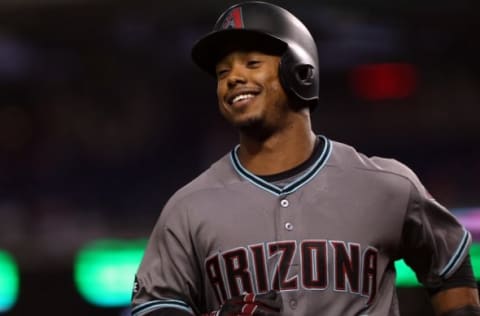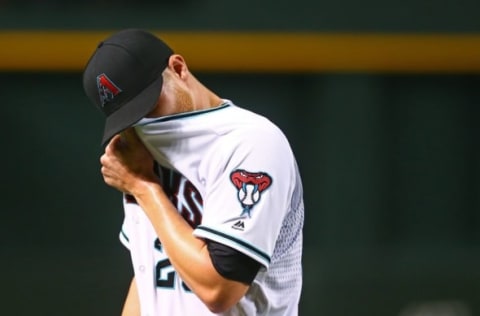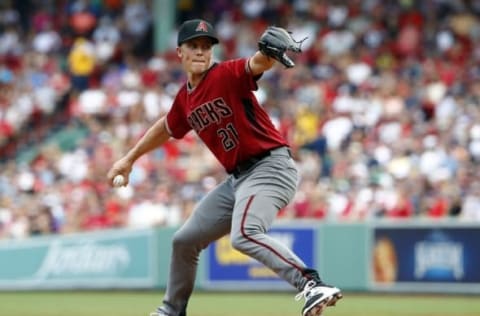Arizona Diamondbacks 2016 Year in Review


Any way you slice it, 2016 was a disappointing year for the Arizona Diamondbacks. Let’s take a closer look at what went right, what went wrong, and what the future might hold.
Every year there seems to be a team that enters the season with high hopes and ambitions, only to fall spectacularly on its face. By the time autumn rolls around, it’s hard to believe expectations were ever that lofty in the first place. You could make a very compelling argument that the Arizona Diamondbacks were that team in 2016.
The D-Backs were surprise heavyweights in last year’s offseason, making some big moves in a bid to become a genuine competitor in the National League West. The biggest? Signing pitcher Zack Greinke to a blockbuster six-year, $206.5 million contract to lead their rotation. Then they made another splash addition to their staff, dealing number-one draft pick Dansby Swanson to the Braves in exchange for Shelby Miller. They also swung a deal with the Brewers for infielder Jean Segura.
Suddenly, the D-Backs looked like they had themselves an imposing roster out in the desert. Greinke was one of the undeniable best starters in the game, coming off a year in which he won 19 games with a 1.66 ERA for the Dodgers. Their offense seemed destined to put a lot of runs on the board with perennial MVP candidate Paul Goldschmidt along with emerging stars A.J. Pollock and David Peralta.
In a division that appeared somewhat open at the start of spring, Arizona was a trendy pick by many to make some noise in the postseason race. Unfortunately, things headed off the rails pretty much immediately. Injuries to key players and underwhelming performances by new additions added up to one very disappointing picture. The D-Backs went 12-14 during the campaign’s first month, which pretty much set the tone for the rest of the year. In fact, the club failed to post an above-.500 record in any individual month this season.
It all really fell apart in July, as the Snakes went an ugly 7-17 during the month and all but buried their chances of salvaging their season. The franchise more or less held the course, however, and you can debate whether that was the correct choice. No one was fired midseason (that came later) and despite some trade buzz swirling around prominent players, none of the major pieces were dealt.
Everything added up to a 69-93 record, 10 games worse than a year ago and good for just fourth place in the NL West. The D-Backs will have a multitude of questions to answer this offseason, starting from the very top of the front office hierarchy. Let’s take a closer look at what went right for Arizona this year, what went wrong, and where they will go from here.
Next: The Good

What Went Right?
What went right for the 2016 Arizona Diamondbacks? Not a whole lot, to be perfectly honest. If they can hang their collective hat on anything, though, it should undoubtedly be their offense. The D-Backs lineup was a rather productive machine this season, scoring the 10th most runs in baseball (752) and posting the 11th-highest OPS (.752). When you look at some of the key players in that batting order, it’s not too hard to see why.
First baseman Paul Goldschmidt just might be the most underappreciated star in the game, even though his numbers were actually down noticeably this year. His .899 OPS was his lowest since 2012, and his home run and RBI totals (24 and 95, respectively) were well below last year’s (33 and 110). The power decrease was reflected in his .192 ISO (isolated power), which is a marked drop from his .249 ISO of a year ago. Goldschmidt still knows how to draw a walk, though, leading the NL with 110 bases on balls. He also swiped a career-high 32 bags, further developing another aspect of his game.
Goldschmidt just turned 29 last month and is under contract through 2019 (through a team option), so the D-Backs will feel confident that he’ll rebound a bit next season and remain a force in the heart of their lineup for the next several years.
Praise should also go to 25-year-old third baseman Jake Lamb. He appeared in 107 games in 2015, slashing a tepid .263/.331/.386. This season – his third in the major leagues – he broke out at the plate, putting up a .249/.332/.509 line with 29 home runs and 91 RBI. However, it should be pointed out that Lamb did most of his damage before the All-Star break. He slashed a meager .197/.283/.380 in the second half while adding just nine of his homers and 30 of his RBI.
Regardless, the D-Backs have to be encouraged by what they saw from the youngster in the earlier part of the season. If he can avoid another late swoon next year, it looks like the team will have another potent offensive weapon on its hands.
The most pleasant surprise of the year may have been second baseman Jean Segura, who really impressed for Arizona following his trade from Milwaukee. He slashed a very robust .319/.368/.499, pacing the NL with 203 hits on the year. His .867 OPS was easily a career high, and .215 better than last year’s mark. He also swatted 20 homers, drove in 64 runs and racked up 33 steals. Segura’s .499 slugging percentage was even .010 points higher than Goldschmidt’s. Not bad for a middle infielder.
Segura is still only 26, and the desert seems to agree with him. Under team control through 2018, the D-Backs have to feel good about him moving forward as well.
Cuban import Yasmany Tomas also showed some improvement in his second MLB campaign. The outfielder belted 31 home runs and collected 83 RBI in 140 games; last year he managed nine homers and 48 RBI in 118 contests. The power surge helped him raise his OPS from .707 to .820 between the two seasons. His defense has been atrocious (-2.4 dWAR), so the club will need him to improve there to make his positive strides at the plate more palatable.
Next: The Bad

What Went Wrong?
If you want to describe what went wrong for the Arizona Diamondbacks this year, you probably need to start with the player everyone was watching before the season even began. Zack Greinke, the $200 million man, was the shiny new toy purchased by a team not known for throwing its financial weight around. While expecting a repeat of his landmark 2015 season would have likely been too much for even the most optimistic observer, most were figuring that he would remain among the game’s very best starters.
It certainly didn’t proceed that way. Greinke was hammered for seven runs in four innings in his first outing for the D-Backs, and he continued to struggle throughout April. He began to turn things around in May and June, but then he hit the DL with an oblique injury that caused him to miss all of July. He faltered again upon returning in early August, and it all added up to a 4.37 ERA, 1.27 WHIP and 3.27 K/BB ratio over 158.2 innings. Definitely not what we have come to expect from Greinke.
While expectations were not quite as high for Shelby Miller, the club was really counting on him to be a solid number-two arm in the rotation. You don’t trade your recent number-one overall draft pick for someone you don’t think is going to help you. To put it bluntly, the plan was an abject disaster. The 25-year-old righty sputtered to a bloated 6.15 ERA, 1.67 WHIP and 1.67 K/BB in 20 outings. It got so ugly that the D-Backs were forced to send him down to Triple-A for a spell in mid-July to try to figure things out.
Of course, the rest of the rotation didn’t perform much better. In fact, Arizona starters posted a 5.19 ERA as a group – only Minnesota was worse (5.39). No pitcher who made at least 10 starts for the D-Backs this year finished the season with an ERA under 4.00. The staff was filled out with several younger hurlers not quite ready for primetime (Robbie Ray, Patrick Corbin, Archie Bradley).
The bullpen was similarly dreadful. D-Backs relief pitchers combined for a 4.94 ERA, third-worst in the league ahead of the Reds (5.09) and Rockies (5.13). It didn’t help that the squad’s two best relievers, Brad Ziegler and Tyler Clippard, were shipped out via midseason trades. After Ziegler converted 18 of 20 save chances as closer, the club turned primarily to Daniel Hudson and Jake Barrett, who went 5-for-7 and 4-for-9, respectively.
In an arid climate and home ballpark that have always been quite friendly to hitters, the Diamondbacks have traditionally struggled to put an effective pitching staff together. (Randy Johnson and Curt Schilling are distant memories.) The 2016 season continued that trend, top to bottom.
Injuries struck some of last season’s biggest offensive contributors as well. A.J. Pollock didn’t make his season debut until August 26 after breaking his right elbow just before Opening Day. This after looking like a star on the rise the year prior, slashing .315/.367/.498 with 20 homers, 76 RBI and 39 steals. Fellow outfielder David Peralta played only 48 games due to wrist and back issues, after breaking out to the tune of an .893 OPS in 2015.
Next: The Future

Now What?
Before even thinking about improving the roster for next year, the Diamondbacks are going to have to get their front office and coaching staff in order. GM Dave Stewart and manager Chip Hale both received their pink slips last week. And former Chief Baseball Officer Tony La Russa will reportedly be retained, but only if he accepts a more limited advisory role.
Arizona is apparently weighing several names in their search for a new general manager, most notably Dodgers executive Ned Colletti. It goes without saying that whoever they choose to lead their baseball operations is going to set the tone for the entire offseason. They’ll instill their philosophy and determine the agenda. So it’s a franchise-altering decision, particularly for a team coming off a very disappointing year and without much sense of direction.
More from Call to the Pen
- Philadelphia Phillies, ready for a stretch run, bomb St. Louis Cardinals
- Philadelphia Phillies: The 4 players on the franchise’s Mount Rushmore
- Boston Red Sox fans should be upset over Mookie Betts’ comment
- Analyzing the Boston Red Sox trade for Dave Henderson and Spike Owen
- 2023 MLB postseason likely to have a strange look without Yankees, Red Sox, Cardinals
Whoever takes over won’t have to deal with very many impending free agents. Only a few D-Backs players are eligible to hit the market, the most prominent being reliever Daniel Hudson and veteran utility man Rickie Weeks. The organization probably won’t be in much of a mood to spend, though, after raising their payroll from about $86 million to just over $103 million a year ago. Despite the monster contract handed to Zack Greinke, Arizona is still one of MLB’s lowest-spending clubs, ranking 26th in payroll. It’s just as well, however, with this year’s free agency class being so weak.
If the D-Backs are going to make any significant upgrades, they will likely come internally or through a trade. There was talk at this season’s trade deadline of them shopping Shelby Miller and maybe even Greinke himself. They could explore that again, but there are reasons to hold off at this time. Namely that their values aren’t exactly at their peak right now.
The offense should remain in good shape next year, especially if Pollock and Peralta stay healthy. Segura maintaining this season’s form and Goldschmidt rebounding a bit would be added bonuses. Whether the team makes a leap forward or not will (naturally) come down to the pitching. Unfortunately, most of their top minor leaguers look at least a couple years away. There probably won’t be any game-changing arms available on the trade market either that will fit into the D-Backs’ price range. Their best bet may be hoping to see vintage Greinke in 2017.
Next: Athletics 2016 Year in Review
All things considered, it’s hard to see this as a team that will bounce back enough to compete next season. The 2017 campaign will be about putting new leadership into place and looking to take some positive steps forward.